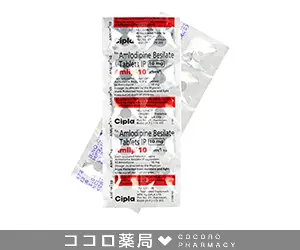過去の健康診断で高血圧と診断されて以来、こちらのお薬を飲むようになってから血圧が安定しています。錠剤も固すぎず、簡単に分割できるくらいなので、分割するときもスムーズにいきます!病院で処方箋を出してもらっていた頃よりも薬代が抑えられていますし、これからもノルバスクジェネリックで血圧管理をしていくつもりでいます!

左記クレジットカード、銀行振込、コンビニ決済に対応



更新日:2025/6/5
ノルバスク・ジェネリックは、高血圧の治療や狭心症の予防効果を持つ医薬品です。
有効成分のアムロジピンペシル酸塩は作用が緩やかで、1回服用すれば効果が24時間持続するという特徴があります。
1日1回のシンプルな服用で治療を進められるのがポイントです。
| メーカー | シプラ(Cipla) |
|---|---|
| 有効成分 | アムロジピンべシル酸塩 |
| 効果 | 高血圧症の改善 狭心症の発作予防 |
| 副作用 | 浮腫や頭痛など |
| 用法 | 1日1回、1回分を服用 |
アムロジピンべシル酸塩には、血管拡張を促す作用があります。血管平滑筋の収縮に関わるカルシウムイオンの通り道を遮断することで、血管平滑筋を弛緩させ、結果的に血管を拡張させて血圧を下げる効果を発揮します。
ノルバスク・ジェネリックには、1錠あたり10mgのアムロジピンペシル酸塩が配合されています。

| 個数 | 販売価格(1錠あたり) | 販売価格(箱) | ポイント | 購入 |
|---|---|---|---|---|
| 30錠 | 93円 | 2,800円 | 84pt | |
| 200錠 | 29円 | 5,800円 | 174pt |






①1万円以上で送料無料
1回の注文で10,000円以上だった場合、1,000円の送料が無料となります。
まとめ買いをすると1商品あたりのコストパフォーマンスが高くなるためおすすめです。
②プライバシー守る安心梱包
外箱に当サイト名や商品名が記載されることはないため、ご家族や配達員など第三者に内容を知られることは御座いません。

③100%メーカー正規品取り扱い
当サイトの商品は100%メーカー正規品となっており、第三者機関による鑑定も行っております。
商品の破損などがあった場合は再配送などにて対応させて頂きますので、ご連絡頂ければ幸いです。

④いつでも購入可能 処方箋不要
サイト上では24時間いつでもご注文を受けております。
また、お電話によるご注文も受け付けておりますのでネットが苦手な方はお気軽にどうぞ。

⑤商品到着100%
商品発送後はお荷物の追跡状況が分かる追跡番号をご案内させて頂きます。
郵便局には保管期限がありますのでご注意ください。
・自宅配達で不在だった場合の保管期限・・・16日間前後
・郵便局留めとした場合の保管期限・・・7~30日間

⑥コンビニ決済利用可能
ご近所のコンビニにていつでもお支払可能です。
セブンイレブンに限り店舗での機械操作を必要とせず、手続き完了後に表示されるバーコードや払込票番号をレジに提示することでお支払い頂けます。

ノルバスクジェネリック 10mg x 30錠
2,800円
ポイント:84pt
10,000円以上購入で送料無料
在庫あり

過去の健康診断で高血圧と診断されて以来、こちらのお薬を飲むようになってから血圧が安定しています。錠剤も固すぎず、簡単に分割できるくらいなので、分割するときもスムーズにいきます!病院で処方箋を出してもらっていた頃よりも薬代が抑えられていますし、これからもノルバスクジェネリックで血圧管理をしていくつもりでいます!
親戚がこちらでの通販を教えてくれました。私は通販じゃなくてもいいんですけど、すごく推奨してくるのでたまに使ってます。ついでに、親戚の分のスキンケア用品をいくつか買わされます。価格がそこそこ安いというのが売りですが、どうしても配送時間がかかるため結果的に不便かなーと思ってしまいます。おそらくですが、この手の薬なら、もっと安いのが病院にあるしなー。
ノルバスクジェネリックは、高血圧の改善だけでなく、狭心症の発作を予防する効果もあります。これは血管を広げる作用があるためで、心臓への負担を減らし血流を改善することで、胸の痛みなどの症状を和らげます。継続的に服用することで、発作の頻度を減らす効果に期待できます。
持続時間が長く、1日1回の服用で安定した効果が得られるのが特徴となっています。他の降圧薬と比べて緩やかに作用し、長時間効果が持続するので日中も夜間も血圧を安定してコントロールできる点がメリットです。
服用後、血圧の低下は6~8時間後に見られます。その後の効果は長時間続きます。1日1回の服用で、血圧を安定させる効果は24時間以上続くことが確認されています。
毎日決まった時間に適切な方法で飲むことが一番の方法です。さらに、減塩や適度な運動、規則正しい生活習慣などを取り入れることで、薬の効果を更に高めることが可能です。
通常は1日1回、ノルバスクジェネリックとして2.5〜5mgから始めます。効果が足りない場合は10mgまで増量することもあります。飲む時間に明確な決まりはありませんが、毎日同じ時間に飲むのが効果を安定させるコツです。
長期間、服用しても問題はないとされています。長期服用の臨床試験では1年の継続服用でも薬の効果は安定しており、薬に対する耐性ができたりすることもなかったという結果もあります。
食前・食後のどちらでも服用できます。食事による影響がほとんどないため、飲みやすいタイミングを選べます。胃が弱く胃への負担を抑えたい場合は食後に服用することで負担を軽減することが可能です。
症状が出ていなくても、高血圧や狭心症は進行することがあります。自己判断でやめると症状が悪化するおそれがあるため、医師から指定された期間はきちんと飲み続けましょう。
肝機能障害や横紋筋融解症、房室ブロックなどがノルバスクジェネリックの重い副作用です。めまいや徐脈、筋肉痛などの症状があらわれた場合、重い副作用の可能性があるため、すぐに医療機関を受診してください。
服用開始時は少ない量から始め、症状に応じて慎重に増量する必要があります。これは高齢者では血中濃度が高くなりやすく、副作用が起こりやすい傾向があるためです。そのため、通常通りの用量で服用を開始するといったことはしないようにすることが大切です。
めまいやふらつきはよく見られる副作用の一つです。めまいやふらつきは事故などに繋がることもあるうえ、急に立ち上がるなどで強く感じることもあるので、症状を感じている場合は急な動作を避けるなど注意が必要です。
むくみや顔のほてり、便秘や吐き気といった軽い副作用が出ることがあります。多くは一時的で継続服用で落ち着くことが多いですが、症状が強く現れていたりする場合は医師に相談しましょう。
| 1日の服用回数 | 1回 |
|---|---|
| 1回の服用量 | 2.5~10mg |
| 服用のタイミング | 指定なし |
| 服用間隔 | 24時間以上 |
| 1日の服用回数 | 1回 |
|---|---|
| 1回の服用量 | 5mg |
| 服用のタイミング | 指定なし |
| 服用間隔 | 24時間以上 |
| 商品名 | ニディカード | ビソプロロール | ロキセン | ハイザール | ラシピル | ネルコニル |
|---|---|---|---|---|---|---|
| 商品画像 |  |  |  |  |  |  |
| 特徴1 | ・長期的な服用も可能 | ・気管支への影響が少なく心臓にのみ作用する | ・全身の血流を改善できる | ・ジェネリックだから安価で治療できる | ・優れた血管拡張作用により、血圧を低下させる | ・カルシウムの血管収縮作用を抑制して降圧効果を発揮する |
| 特徴2 | ・高血圧症だけでなく狭心症の治療・予防にも有効 | ・内因性の交感神経刺激作用がない | ・高血圧症治療に効果的 | ・ふたつの成分が効果的に血圧を下げる | ・適切な血圧を保つことで将来の健康を守る | ・全身の血管に拡張作用を示すことから狭心症の治療に用いることも可能 |
| 内容量 | 10mg30錠x1箱 | 5mg30錠x1箱 | 20mg30錠x1箱 | 50mg/12.5mgx28錠 | 4mg28錠x1箱 | 20mg30錠x1箱 |
| 価格 | 4,960円 | 3,860円 | 4,560円 | 4,060円 | 6,560円 | 3,200円 |
| 0.1〜1%未満 | 0.1%未満 | 頻度不明 | |
| 肝臓 | ALT、ASTの上昇、肝機能障害、ALP、LDHの上昇 | γ-GTP上昇、黄疸 | 腹水 |
| 循環器 | 浮腫注1)、ほてり(熱感、顔面潮紅等)、動悸、血圧低下 | 胸痛、期外収縮、洞房又は房室ブロック、洞停止、心房細動、失神、頻脈 | 徐脈 |
| 精神・神経系 | めまい・ふらつき、頭痛・頭重 | 眠気、振戦、末梢神経障害 | 気分動揺、不眠、錐体外路症状 |
| 消化器 | 心窩部痛、便秘、嘔気・嘔吐 | 口渇、消化不良、下痢・軟便、排便回数増加、口内炎、腹部膨満、胃腸炎 | 膵炎 |
| 筋・骨格系 | 筋緊張亢進、筋痙攣、背痛 | 関節痛、筋肉痛 | |
| 泌尿・生殖器 | BUN上昇 | クレアチニン上昇、頻尿・夜間頻尿、尿管結石、尿潜血陽性、尿中蛋白陽性 | 勃起障害、排尿障害 |
| 代謝異常 | 血清コレステロール上昇、CK上昇、高血糖、糖尿病、尿中ブドウ糖陽性 | ||
| 血液 | 赤血球、ヘモグロビン、白血球の減少、白血球増加、紫斑 | 血小板減少 | |
| 過敏症 | 発疹 | そう痒、じん麻疹、光線過敏症 | 多形紅斑、血管炎、血管浮腫 |
| 口腔 | (連用により)歯肉肥厚 | ||
| その他 | 全身倦怠感 | しびれ、脱力感、耳鳴、鼻出血、味覚異常、疲労、咳、発熱、視力異常、呼吸困難、異常感覚、多汗、血中カリウム減少 | 女性化乳房、脱毛、鼻炎、体重増加、体重減少、疼痛、皮膚変色 |
本製品は海外製のため、期限表記が日本と異なる場合がございます。
パッケージ裏面や側面、シートなどに以下のような表記がされています。
| EXP | 使用期限 例:EXP 12/2025→2025年12月まで使用可 |
|---|---|
| MFG または MFD | 製造日 例:MFG 03/2023 |
| BEST BEFORE | 品質が最も安定している目安日 |


※国や製品により日付の並び(例:月/年、日/月/年)が異なる場合がありますのでご注意ください
EXP(Expiry Date) の表記がなく、MFG または MFDしか記載がないケースがあります。
この場合は MFG(MFD) から2~3年が使用期限の目安です。
※「LOT」や「BATCH」の表記は製造番号であり期限ではありません。

パッケージ例となります。
商品やご注文単位によってはシート単位でのお届けとなる場合が御座います。
外箱に当サイト名や商品名が記載されることはないため、ご家族や配達員など第三者に内容を知られることは御座いません。
かれこれ7ヶ月は飲み続けています。錠剤が砕けやすく、割るときに力任せにいくと粉々になりやすいので注意が必要です。前の薬よりも効果が高いのか、血圧を良い状態でしっかり維持できております。飲んだあと、ふらつくことがあるため、そこはちょっと気をつけたほうがいいです。
過去の健康診断で高血圧と診断されて以来、こちらのお薬を飲むようになってから血圧が安定しています。錠剤も固すぎず、簡単に分割できるくらいなので、分割するときもスムーズにいきます!病院で処方箋を出してもらっていた頃よりも薬代が抑えられていますし、これからもノルバスクジェネリックで血圧管理をしていくつもりでいます!
処方箋なしで病院と同じ薬を買えます。病院の薬も飲みましたが違いは感じませんし、とてもおすすめです。しかも、薬代と診察費を考えてもこんなに安く買えるのはびっくりです。200錠入りだったら1錠あたり30円になる!あえて言うなら30錠と200錠の中間くらいのサイズ感があればいいなと思います。
高血圧症の治療のため近所の病院で先発薬を処方してもらっていましたが、医療費が圧迫してきたのと通院が面倒なのでこちらへ変更してみました。2ヶ月ほど続けていますが現時点で異変はありません。服用量が多くなると副作用が現れるようですが、ちゃんと調節すれば大丈夫ですよ。もともと飲んだことのある薬なら問題ありません。
血液検査で血圧が高いと指摘され、治療をしなければならないと言われました。なるべく薬は飲みたくなかったんですが、やはり薬に頼らなければ改善されなさそうなので、まずはこちらを。飲み始めたばかりなので効果は分かりませんが、口コミも良さげだったのできっと効くと思ってます。効果が出ればまた買います。
商品口コミの投稿は会員のみ行えるようになっております。
お手数ですが会員ログインの上でご投稿頂きますようお願いいたします。
口コミをご投稿頂いたお客様にはポイントをプレゼントさせて頂いております。
文章のみであれば100ポイント、文章+写真付きのものは300ポイントをプレゼントさせて頂きます。
規約や詳細などはこちらをご確認くださいませ。